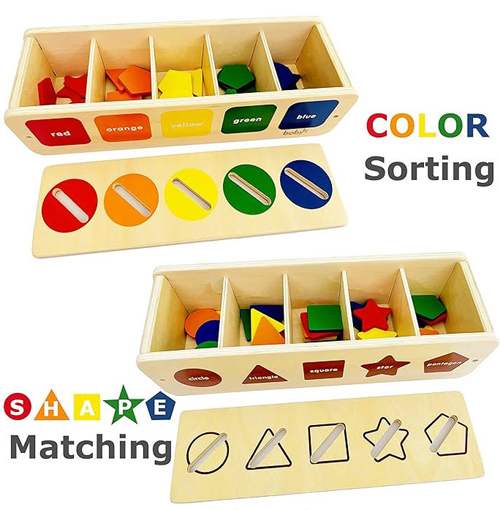Table of Contents
The Power of Sorting and Matching
- Cognitive Skill Development: Sorting and matching toys enhance cognitive skills like recognizing patterns, categorizing objects, and solving problems. They challenge children to think critically and develop logical reasoning.
- Math Readiness: These toys develop essential math skills such as pattern recognition, counting, and organization. They lay the groundwork for understanding addition, subtraction, and grouping.
- Fine Motor Skill Enhancement: Many sorting and matching toys involve manipulating small objects, which helps develop fine motor skills and hand-eye coordination. These skills are necessary for everyday tasks like writing and drawing.
- Language Development: Sorting and matching activities can expand a child’s vocabulary as they learn to identify and name different colors, shapes, and objects.
- Problem-Solving and Critical Thinking: By figuring out how items relate to each other, children enhance their problem-solving skills. They learn to sort items based on various criteria, like color, shape, size, or type.
- Real-Life Applications: Sorting and matching activities mimic daily tasks, such as organizing toys, groceries, or laundry. These skills are transferable to real-world situations.
- Confidence in Learning: Successfully matching and sorting items gives children a sense of accomplishment, boosting their confidence and fostering a love for learning.

Types of Sorting and Matching Toys
- Shape Sorters: Classic toys where children fit different shapes into corresponding holes. >> To buy in Amazon
- Color Sorting Toys: Toys that involve sorting objects by color, such as colored blocks or stacking rings. >> To buy in Amazon
- Matching Card Games: Games where children match pairs of cards with similar images or patterns. >> To buy in Amazon
- Object Sorting Sets: Sets of various objects (animals, fruits, vehicles) that children sort by type. >> To buy in Amazon
- Pattern Blocks: Sets of geometric shapes that can be used to create patterns and designs. >> To buy in Amazon
- Puzzle with Matching Elements: Puzzles where pieces need to be matched based on color, shape, or image. >> To buy in Amazon
- Montessori Sorting Toys: Toys designed based on the Montessori method, often involving natural materials and focusing on specific skills.>> To buy in Amazon
How to Use Sorting and Matching Toys for Learning
- Start Simple: Begin with basic sorting and matching tasks, such as matching identical objects or sorting by a single attribute (e.g., color).
- Introduce New Challenges Gradually: As children progress, introduce more complex sorting and matching activities, such as sorting by multiple attributes (e.g., color and shape) or matching related objects.
- Use Everyday Objects: Incorporate sorting and matching into daily routines. For example, have children sort socks by color or match pairs of shoes.
- Make it Fun and Engaging: Turn sorting and matching into a game. Use colorful toys, create challenges, and offer praise and encouragement.
- Encourage Exploration: Let children explore the toys in their own way. There’s no single “right” way to play.
- Ask Open-Ended Questions: Encourage critical thinking by asking questions like, “How are these two things the same?” or “Can you find another object that belongs in this group?”
By providing children with a variety of sorting and matching toys and incorporating these activities into playtime, you can help them develop essential cognitive skills while having fun.
